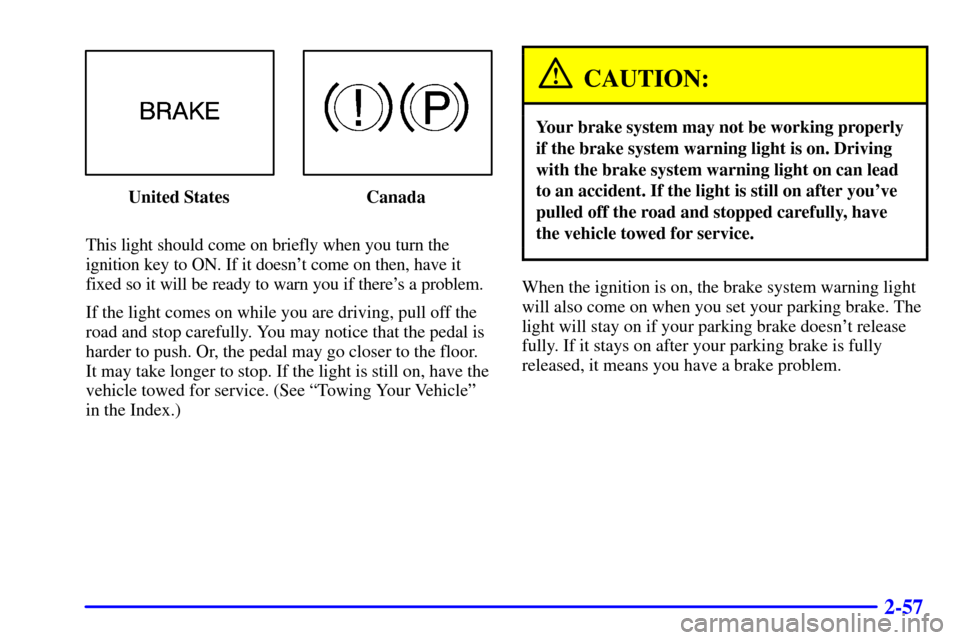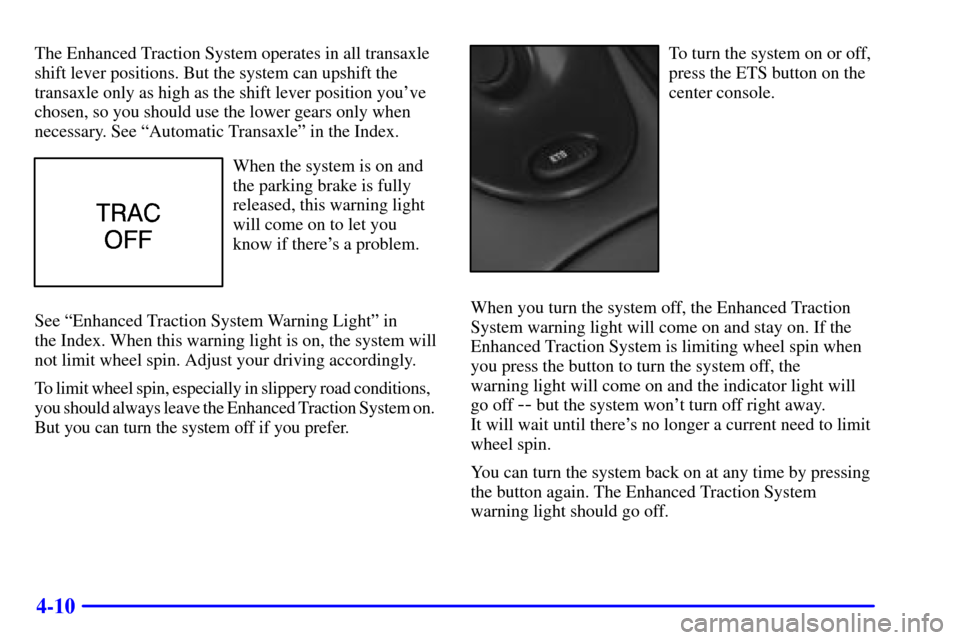Page 107 of 327

2-42
Turn the turn signal lever end cap up two positions to
turn on your:
�Headlamps
�Parking Lamps
�Sidemarker Lamps
�Taillamps
�License Plate Lamps
�Instrument Panel Lights
Turn the switch to OFF to turn all of the lamps off.
Lamps On Reminder
If you turn off the ignition and open the driver's
door while leaving the lamps on, you will hear a
warning chime.
Daytime Running Lamps
Daytime Running Lamps (DRL) can make it easier
for others to see the front of your vehicle during the
day. DRL can be helpful in many different driving
conditions, but they can be especially helpful in the
short periods after dawn and before sunset.
The DRL system will make your high
-beam headlamps
come on at a reduced brightness when:
�The ignition is on,
�the headlamp switch is in OFF or you have turned on
your parking lamps,
�the light sensor detects daytime light,
�the parking brake is released and
�the shift lever is not in PARK (P) on vehicles with an
automatic transaxle only.
When the DRL system is on, the taillamps, sidemarker
lamps, park lamps and instrument panel lights will not
be illuminated.
As with any vehicle, you should turn on the regular
headlamp system when you need it.
Page 108 of 327

2-43 Automatic Light Control (ALC)
When it is dark enough outside, your Automatic Light
Control (ALC) will turn on your headlamps along with
other lamps such as the taillamps, sidemarker lamps,
park lamps and the instrument panel lights. The radio
lights will also be dim.
Your vehicle is equipped with a light sensor on the top
of the instrument panel under the defroster grill, so be
sure it is not covered. This will cause the ALC system
to be on whenever the ignition is on.
The ALC system may also come on when driving
through a parking garage, heavy overcast weather or a
tunnel. This is normal.
There is a delay in the transition between the daytime
and nighttime operation of the DRL and the ALC
systems so that driving under bridges or bright overhead
street lights does not affect the system. The DRL and
ALC systems will only be affected when the light sensor
sees a change in lighting lasting longer than this delay.
To idle your vehicle with the ALC system off, set the
parking brake while the ignition is off. Then start the
vehicle. The ALC system will stay off until you release
the parking brake.
As with any vehicle, you should turn on the regular
headlamp system when you need it.
Delayed Headlamps
The delayed headlamps feature will continue to
illuminate the headlamps for 20 seconds after the
key is turned to OFF, then the headlamps will
automatically turn off.
To override the 20 second delayed headlamp feature
while it is active turn the turn signal/multifunction lever
up one position and then back to OFF.
Fog Lamps (If Equipped)
The button for your fog lamps is located on the
instrument panel, to the left of the steering wheel,
beside the instrument panel intensity control.
When using the fog lamps, the ignition must be on as
well as the parking lamps or the low
-beam headlamps.
Push the button to turn the fog lamps on. An indicator
light on the button will glow when the fog lamps are on.
Push the button again to turn the fog lamps off.
The fog lamps will turn off whenever the high
-beam
headlamps are turned on. When the high beams are
turned off, the fog lamps will come on again.
Page 116 of 327
2-51
Your instrument panel is designed to let you know at a glance how your vehicle is running. You'll know how fast
you're going, how much fuel you're using, and many other things you'll need to drive safely and economically.
The main components of your instrument panel are:
A. Fuse Panels
B. Vents
C. Instrument Cluster Panel
D. Hazard Warning Button
E. Audio System
F. Climate Control
G. Auxiliary Power Accessory Outlet
H. Cigarette Lighter/Power Accessory Outlet
I. Parking BrakeJ. Transaxle Shift Lever
K. Enhanced Traction System Switch
L. Windshield Wiper/Washer Lever
M. Ignition Switch
N. Cruise Control Switches (If Equipped)
O. Tilt Wheel Lever
P. Hood Release Handle
Q. Turn Signal/Multifunction Lever
R. Instrument Panel Intensity Control
Page 122 of 327

2-57
United States Canada
This light should come on briefly when you turn the
ignition key to ON. If it doesn't come on then, have it
fixed so it will be ready to warn you if there's a problem.
If the light comes on while you are driving, pull off the
road and stop carefully. You may notice that the pedal is
harder to push. Or, the pedal may go closer to the floor.
It may take longer to stop. If the light is still on, have the
vehicle towed for service. (See ªTowing Your Vehicleº
in the Index.)
CAUTION:
Your brake system may not be working properly
if the brake system warning light is on. Driving
with the brake system warning light on can lead
to an accident. If the light is still on after you've
pulled off the road and stopped carefully, have
the vehicle towed for service.
When the ignition is on, the brake system warning light
will also come on when you set your parking brake. The
light will stay on if your parking brake doesn't release
fully. If it stays on after your parking brake is fully
released, it means you have a brake problem.
Page 124 of 327

2-59
The Enhanced Traction System warning light may come
on for the following reasons:
�If you turn the system off by pressing the ETS button
on the center console near the gear shift lever, the
warning light will come on and stay on. To turn the
system back on, press the button again. The warning
light should go off. (See ªEnhanced Traction
Systemº in the Index for more information.)
�The warning light will come on when you set your
parking brake with the engine running, and it will
stay on if your parking brake doesn't release fully.
If the system is turned on and the warning light
stays on after your parking brake is fully released,
it means there's a problem with the system.
�If the traction control system is affected by an
engine
-related problem, the system will turn off
and the warning light will come on.
If the Enhanced Traction System warning light comes
on and stays on for an extended period of time when
the system is turned on and the parking brake is fully
released, your vehicle needs service.
Enhanced Traction System Active Light
When your Enhanced
Traction System is
limiting wheel spin,
this light will come on.
Slippery road conditions
may exist if the Enhanced
Traction System active
light comes on, so adjust
your driving accordingly.
The light will stay on for a few seconds after the
Enhanced Traction System stops limiting wheel spin.
This light will also come on when the anti
-lock brake
system is active.
The Enhanced Traction System active light also comes
on briefly when you turn the ignition key to ON. If the
light doesn't come on then, have it fixed so it will be
there to tell you when the system is active.
Page 168 of 327

4-10
The Enhanced Traction System operates in all transaxle
shift lever positions. But the system can upshift the
transaxle only as high as the shift lever position you've
chosen, so you should use the lower gears only when
necessary. See ªAutomatic Transaxleº in the Index.
When the system is on and
the parking brake is fully
released, this warning light
will come on to let you
know if there's a problem.
See ªEnhanced Traction System Warning Lightº in
the Index. When this warning light is on, the system will
not limit wheel spin. Adjust your driving accordingly.
To limit wheel spin, especially in slippery road conditions,
you should always leave the Enhanced Traction System on.
But you can turn the system off if you prefer.
To turn the system on or off,
press the ETS button on the
center console.
When you turn the system off, the Enhanced Traction
System warning light will come on and stay on. If the
Enhanced Traction System is limiting wheel spin when
you press the button to turn the system off, the
warning light will come on and the indicator light will
go off
-- but the system won't turn off right away.
It will wait until there's no longer a current need to limit
wheel spin.
You can turn the system back on at any time by pressing
the button again. The Enhanced Traction System
warning light should go off.
Page 187 of 327

4-29
Then, shut the engine off and close the window almost
all the way to preserve the heat. Start the engine again
and repeat this only when you feel really uncomfortable
from the cold. But do it as little as possible. Preserve the
fuel as long as you can. To help keep warm, you can get
out of the vehicle and do some fairly vigorous exercises
every half hour or so until help comes.
Recreational Vehicle Towing
You can tow your vehicle behind another vehicle for use
at your destination. Be sure to use the proper towing
equipment designed for recreational towing. Follow the
instructions for the towing equipment.
Towing Your Vehicle from the Front
There are two ways to tow your vehicle from the front.
To tow your vehicle with a dolly, follow these steps:
�Put the front wheels on a dolly.
�Put the vehicle in PARK (P) for automatic transaxle
and NEUTRAL for a manual transaxle.
�Set the parking brake and then remove the key.
�Clamp the steering wheel in a straight
-ahead position
with a clamping device designed for towing.
�Release the parking brake.
Page 188 of 327
4-30
To tow your vehicle with all four wheels on the ground,
follow these steps:
1. Position the vehicle to tow and then secure it.
2. Turn the ignition switch to OFF.
3. Set the parking brake.4. Remove the following fuses from the left side of the
instrument panel fuse block: A) Radio, B) Radio,
C) Wiper, H) BFC Batt, I) PCM Batt, K) IPC/BFC
ACC. This will prevent your battery from draining
while towing. See ªInstrument Panel Fuse
Block
- Leftº in Section 6 for the location of
these fuses.
5. Turn the ignition switch to ACC.
6. Shift your transaxle to NEUTRAL (N).
7. Release the parking brake.
Remember to replace the fuses once you reach your
destination. To replace a fuse:
1. Set the parking brake.
2. Remove the key from the ignition switch.
3. Replace the fuse.
NOTICE:
Make sure that the towing speed does not exceed
65 mph (110 km/h), or your vehicle could be
badly damaged.